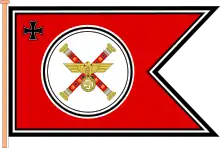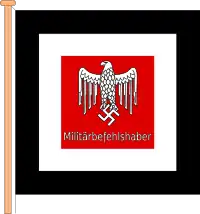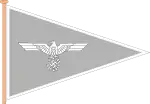List of flags of the Wehrmacht and Heer (1933–1945)
This article shows a list of flags of the German Wehrmacht and Heer which were used in the years between 1933 and 1945 by the German Reichswehr, Wehrmacht and Heer.
Supreme command flags of the Reichswehr and Wehrmacht
| Flag | Dates | Designation | Description |
|---|---|---|---|
 | 1933–1935 | Command flag for the Reichswehr minister | The flag was introduced on 14 March 1933 and was used until 23 July 1935. The position of Reichswehr Minister and Commander-in-Chief of the Wehrmacht was held since 30 January 1933 by Werner von Blomberg. |
 | 1935 | Command flag for the Reichskriegsminister and Commander-in-Chief of the Wehrmacht | Adopted on 23 July 1935 and used until 5 October 1935. The name was changed to Reich Ministry of War on 21 May 1935. |
 | 1935–1938 | Command flag for the Reichskriegsminister and Commander-in-Chief of the Wehrmacht | Adopted on 5 October 1935 and used until 4 February 1938. Following Blomberg's dismissal in February 1938, Adolf Hitler, himself assumed the position of Commander-in-Chief of the Wehrmacht. The command flag was therefore no longer used and replaced by the following: |
 | 1938–1945 | Personal standard of Adolf Hitler as Commander-in-Chief of the Wehrmacht | Adolf Hitler's personal standard, adopted 11 April 1935, and was also used to represent the Commander-in-Chief of the Wehrmacht after Blomberg's dismissal. Since 19 December 1941, it also served as the command flag for the commander-in-chief of the army, following Hitler's takeover of the position. |
 | 1938–1941 | Command flag for the Chief of the Armed Forces High Command | With the direct assumption of command over the Wehrmacht by Hitler, the Reich Ministry of War was dissolved and replaced by a newly created Oberkommando der Wehrmacht (OKW). Its chief was from the beginning until the end of the war, Wilhelm Keitel. The flag was adopted on 6 August 1938 and used exclusively on motor vehicles. It had the same dimensions as below. |
 | 1941–1945 | Command flag for the Chief of the Armed Forces High Command | Introduced 7 April 1941, following Keitel's promotion to field marshal on 19 July 1940. The flag was also used only on motor vehicles. It had a length-to-height ratio of 5 to 3. In practice it was 30 cm high, 45 cm long and had a 15 cm deep incision. In the white central circle were two crossed field marshals, on which an imperial eagle had been placed. This sat on a wreath, which included an upright swastika. |
Supreme command flags of occupied territories
| Flag | Dates | Designation | Description |
|---|---|---|---|
 | 1940–1945 | Commander flag for a Militärbefehlshaber | A Militärbefehlshaber was the head of all civilian facilities in an occupied territory (police, administration, etc.) and a member of the Wehrmacht. The flag was square in shape, but did not have a well-defined size. |
 | 1940–1945 | Commander flag for a Wehrmachtbefehlshaber | A Wehrmachtbefehlshaber was the head of all military units in an occupied territory that was not under military administration. The flag was square in shape, but did not have a well-defined size. |
Supreme command flags of the Heer
| Flag | Dates | Designation | Description |
|---|---|---|---|
 | 1933–1935 | Flag for the Supreme Commander of the Army | Used between February 1934 and June 1935 with the designation Flag of the Chief of the Army Command . The position of Commander-in-Chief of the Army was held from 1932 to 1938 by Werner von Fritsch. |
 | 1935–1941 | Flag for the Supreme Commander of the Army | In 1938 Walther von Brauchitsch took over command. When Adolf Hitler made himself commander-in-chief of the Army, in 19 December 1941. The flag was thus no longer used, and was replaced by the personal standard of Adolf Hitler (see above). |
 | 1944–1945 | Flag for the Chief of the OKH General Staffs | The flag was introduced on 1 September 1944 and used until shortly before the end of the war. Since the position of Chief of the Army General Staff was Heinz Guderian during this period, the flag was mainly associated with him. |
 | 1941–1945 | Vehicle pennant for Generalfeldmarschälles of the Heer | The flag was introduced on 23 April 1941. It was of square and had a length of 30 cm. |
 | 1941–1945 | Vehicle pennant for Generals of the Heer | The pennant was introduced on 23 April 1941. The length was 35 cm and a height of 23 cm. |
 | 1941–1945 | Vehicle pennant for the remaining members of the Heer | The pennant was introduced on 23 April 1941. The length was 30 cm and a height of 20 cm. |
 | 1941–1945 | Command flag for the commander-in-chief of an army group | |
 | 1933–1945 | Command flag for the commander-in-chief of an army command | Until 1941, called the "flag for the staff of an army commando". |
 | 1941–1945 | Command flag for the commander of a panzer group | |
 | 1933–1945 | Command flag for the commanding general of an army corps | Until 1941, called the "Flag for the Staff of a General Command". |
 | 1933–1945 | Command flag for the commander of a division | Until 1941, called the "flag for the staff of a division". |
Literatur
- Davis, Brian Leigh (1984). Flags & standards of the Third Reich: Army, navy, & air force, 1933-1945. Arco Pub. ISBN 978-0668036207.
- Oberkommando der Kriegsmarine (1992). Das große Flaggenbuch (in German). Mauritius Buch Verlag. ISBN 978-3980334204.
External links
This article is issued from Wikipedia. The text is licensed under Creative Commons - Attribution - Sharealike. Additional terms may apply for the media files.